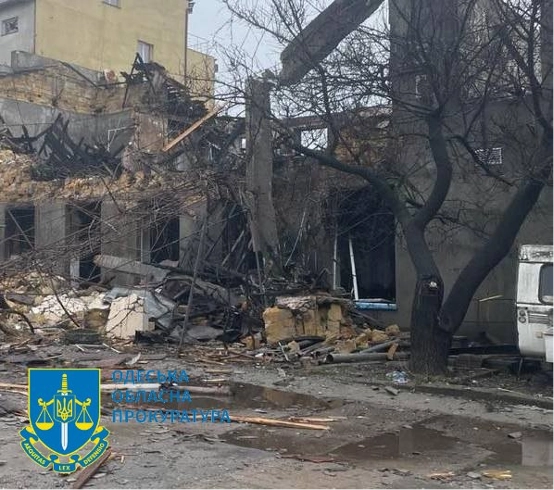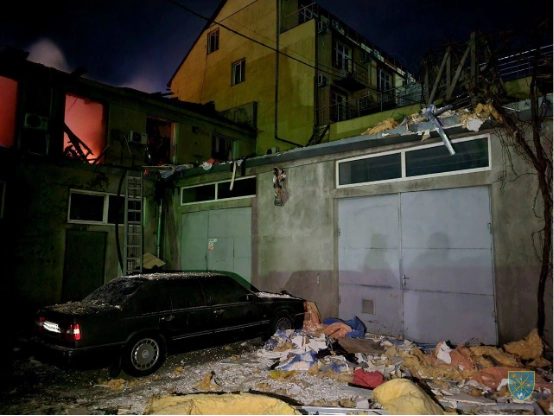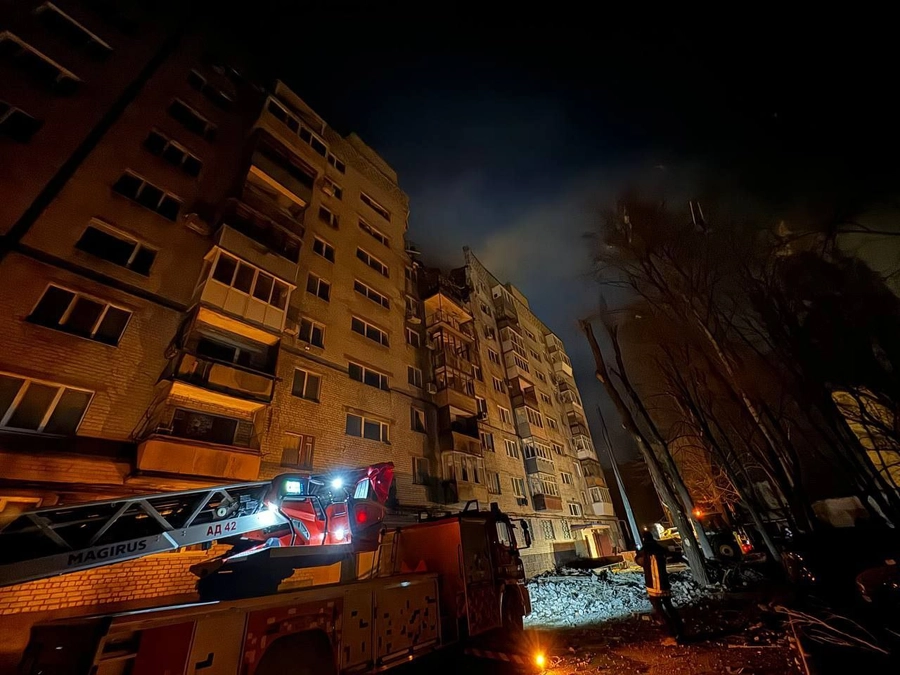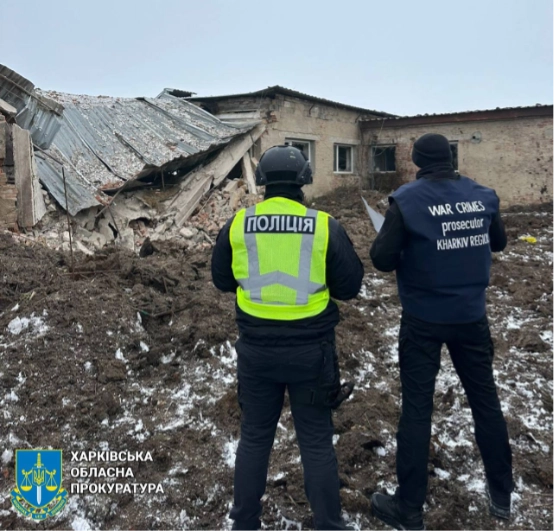Former Russian president Dmitriy Medvedev on Thursday said all Russians love the Ukrainian city of Odesa and hope and pray for its return to the Russian fold.
Later the same day the Kremlin hit the Black Sea port with kamikaze drones, killing three residents including a child.
JOIN US ON TELEGRAM
Follow our coverage of the war on the @Kyivpost_official.
“Odesa, come back home! We have waited and waited for Odesa in the Russian Federation,” said Medvedev, current Deputy head of Russia’s National Security Council.
“We (in Russia) have been waiting for this city, for its entire history. Because of the type of people that live here, considering the language that they speak, this (Odesa) is ours, a Russian Federation city, an ethnic Russian city,” he said.
A Russian Shahed drone demolished the premises of an privately-owned construction company in the Ukrainian port city Odesa shortly before midnight on Feb. 22. Some six hours prior to the Kremlin strike, Dmitriy Medvedev, former Russian President and current head of the National Security Council of Russia, called Odesa a “pure Russian city” and called on Odesa residents to reject loyalty to Kyiv in favor of Moscow.
The former Russian leader published the comments calling for Kremlin annexation of the million-resident city in the form of an interview, on his personal Telegram channel at 9 a.m. on Thursday.
Occupation and integration of Ukrainian cities and regions where Russian is often spoken are declared Russian war aims. International law and the UN Charter bans invading a neighboring country on those grounds.

What Did Donald Trump Say About Ukraine in His Big Speech to Congress?
Technicians at two locations – Prymorsko-Akhtarsk in Russia’s southern Krasnodar region, and Cape Chauda, a spit of land on the east end of Ukraine’s Russia-occupied Crimean region – began launching Shahed kamikaze drones in a north-eastern vector, out across the Black Sea, toward Odesa, almost exactly twelve hours later.
Roughly the size of a Mini 3-door or a king-sized bed, and manufactured by Tehran’s Shahed Aviation Industries, the wedge-shaped propeller-driven robot plane cruises at about 185 kilometers an hour and carries a 50-kilogram warhead.
According to open-source reports, the Russian Federation probably pays Iran about $300,000 for each drone. The first Shahed appeared in Ukrainian skies in September 2023.
By January 2024, the Kremlin had launched close to 4,000 of the flying bombs at Ukrainian homes and businesses. Moscow has claimed the weapons are aimed only at military targets, but in hundreds of strikes the drone’s primitive inertial guidance system – a World War II technology – has seemed unable to reliably and precisely hit anything smaller than a city block or a seaport.
Kyiv has charged Russia targets civilians as part of a strategy attempting to force Ukrainian surrender by breaking public morale.
According to Ukrainian air defense reports from early Friday morning, a total of 31 Shaheds launched in flights of four to six and buzzed through the central Black Sea’s nighttime skies toward the Ukrainian cities of Mykolaiv, Poltava, Dnipro and Kharkiv. Judging by weapon types and counts, Odesa appears to have been the Kremlin’s priority target for the evening.
The Russian Air Force planners, based on tracking and later strike reports appearing in Ukrainian media, used tactics differing little from attacks against Ukraine taking place every other night or so, for at least the past six months.
Coveys of Shaheds flew low along separate routes to confuse Ukrainian air defenses, and simultaneously, a small number of expensive heavy missiles carrying warheads in the quarter- to half-ton range, were thrown into the mix.
According to the Ukrainian Air Force statements, besides the 31 kamikaze drones, Russia on late on Thursday evening launched three S-300 ballistic missiles from a site in Ukraine’s eastern Donetsk region, one X-31P anti-radar missile from an unspecified location, and two X-22 cruise missiles dropped by a Russian Air Force bomber or bombers flying over the Black Sea.
Ukrainian air defenses have become practiced at receiving incoming Russian drone and missile strikes, and as midnight approach a mix of anti-aircraft cannon, interceptor missiles, and gun crews operating heavy machine guns knocked down 23 of the drones.
The deadly X-22s aimed at Odesa went off course, official statements said. Some military information platforms speculated Ukrainian military jammers made the missiles dive into the Black Sea. Kyiv Post could not confirm the reports.
A minority of the Russian weapons got through. Compared to hundreds of previous drone and missile strikes launched on Ukraine by Russia, Odesa aside, the Friday attack delivered average destruction.
A fire in the Ukrainian southern port city Odesa burns on Feb. 23 following a strike by a Iran-manufactured robot bomb launched by the Russian military. The kamikaze drone hit the premises of a local construction firm. An apartment building is next door. Ukrainian officials reported three civilians died in the attack. Image published by Ukraine’s Joint Forces South.
One Shahed hit an eight story hi-rise building in Dnipro, demolishing two apartments and injuring eight people. Two were hospitalized. Rescue workers were searching for more possible survivors by mid-morning Friday.
Firemen respond to damage following a strike by a Russian Shahed drone strike on the upper stories of an apartment building in the southern Ukrainian city Dnipro, on Feb. 23. The Iran-manufactured weapon demolished two homes and injured eight persons. Two were hospitalized. Official image published by Ukraine’s Ministry of Emergency Situations.
Another Shahed hit a Dnipro region fuel base ruining four oil storage tanks and touching off a fire, Volodymyr Orlov, a spokesperson for the regional defense command, said in a statement.
Authorities in Ukraine’s north-eastern Kharkiv region reported five Shahed drones pounded a cattle farm near the remote village of Mokra Rokytna shortly before midnight. The blast chain collapsed animal housing, storage buildings, set fires, and demolished farm equipment. According to local reports, cows and calves were killed in the strike, but no people were hurt.
Ukrainian officials observe a building at a Kharkiv region dairy following a Russian Shahed drone strike in the early morning hours of Feb. 23. A reported 15 cattle died in the strike near the village Mokra Rotyna. An as-yet undetermined number of calves were killed as well. No people were hurt. Official image published by the Kharkiv regional adminstration.
The worst casualties of the night were In Odesa, where a single Shahed possibly aimed at civilian port facilities in the neighborhood plowed, at about 11:00 p.m., into a privately-owned construction firm in a residential-commercial district.
According to a statement by Odesa Mayor Gennady Trukhanov, the Iranian flying bomb was hit by ground gunners over the water but made it to the shore before blowing up.
The Russian weapon’s blast according to official counts killed three Odesa residents, among them a child.
The explosion also collapsed a low-rise building and damaged neighboring structures. Emergency response teams and firemen were on the scene in minutes and had ended a search for survivors by 7 a.m. A 500-meter-square fire was extinguished, a statement from the Emergency Situations Ministry said.
A seaport founded by Imperial Russia in the late 18th century, Odesa is Ukraine’s third- or fourth-biggest city by population and its largest seaport.
By tradition, city governments in Odesa have been fiercely independent, internationally oriented, skilled traders. According to critics, over the years many Odesa businessmen have made fortunes in smuggling and tax evasion.
Russian is more commonly spoken than Ukrainian in Odesa, but the language differs dramatically from Russian used in the Russian Federation. For most Russian speakers, speech used by a typical Odesa resident due to foreign words, slang and cadence is at least as dissimilar to literary Russian, as US Southern or outback Australian English differs from language aired on the BBC.
The distinctive Odesa brand of Russian has been a focus of fierce civic pride since at least the mid-19th century and has been celebrated over the years by local literary heroes including the novelist Isaac Babel, the Ilf and Petrov writing duo, and the stand-up comic Mikhail Zhvanetsky.
Like most Ukrainians, residents of modern Odesa are usually bilingual.
You can also highlight the text and press Ctrl + Enter















